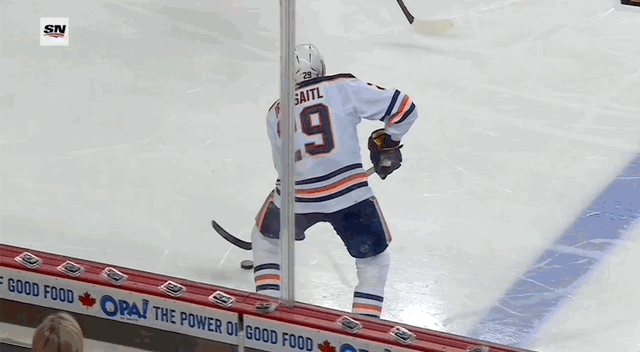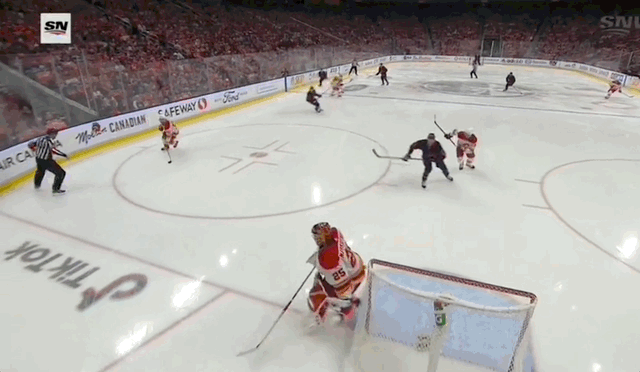In what’s been a relatively bland second round of the Stanley Cup Playoffs, the Battle of Alberta brought the chaos.
The series went five games, with the Calgary Flames, who finished first in the Pacific, being ousted by the Pacific’s second seed Edmonton Oilers.
So what burned the Flames this series? And what sparked the Oilers? Let’s look at three key factors in this series.
Connor McDavid’s dominance
For the Oilers, star power led the way.
In Round 2, no one generated more offence than the Oilers did with McDavid deployed in all situations. Edmonton created 11.8 expected goals for, and exceeded those expectations with 18 tallies when McDavid was on the ice (which also leads the league). Leon Draisaitl, who played much of this series on the wing alongside the generational centre, finished second in both metrics. Calgary managed just six goals in that time, as well.
Even if we take out power play time and focus in at 5-on-5, McDavid’s performance stands tall above the rest. With McDavid on the ice in those situations, the Oilers outscored Calgary 14-5. His speedy and evasive skating helped him enter the zone with the puck on his stick a league-leading 28 times in Round 2. Thirteen of those entries led to a shot on goal being generated, and 14 times a scoring chance was created. In the offensive zone, he still moved the puck at a high rate and to the quality areas with 12.5 per 60 pass attempts to the slot that connected successfully about 50 per cent of the time.
What also helped McDavid’s game was Draisaitl’s set ups; he actually clicked at a slightly higher percentage with his offensive zone passing and passes to the slot than McDavid. The drawback of pairing these two together at 5-on-5 is that the Oilers run the risk of making their lineup too top-heavy. The benefit is that it forces defenders to try to stop two of the best offensive forces in the league at the same time. That’s why both were able to get to the quality areas and generate scoring chances at a high rate.
Both deserve credit for their efforts — Draisaitl did finish higher in scoring in these situations with 13 points to McDavid’s nine. Playing with another elite player helped facilitate his game, but it was clear that above all else this series was McDavid just taking over games to push his team to the Western Conference Final.
Flames offence doused
If we’re talking about the Oilers’ best, we have to look across the way to the Flames. Their top line of Johnny Gaudreau, Elias Lindholm, and Matthew Tkachuk was one of the best combinations in the regular season. It wasn’t that they weren’t effective in this series at all, or that this loss falls on them. That said, they weren’t the same spark they were in the regular season.
Edmonton’s second line was really successful and Zach Hyman had a lot to do with that; the Oilers outscored Calgary 10-3 with him on the ice at 5-on-5. The Flames’ second line of Andrew Mangiapane, Mikael Backlund, and Blake Coleman generated quality offence and outscored their opponents 7-3 throughout the post-season.
But Calgary’s top line and bottom-six didn’t generate enough. With their leading trio on the ice, the team was outscored 7-4 at 5-on-5. Sure they didn’t have great shooting luck or goaltending in those minutes (and we’ll get there), but they didn’t create enough quality offence either.
Gaudreau was second in the league in Round 2, only behind McDavid, with 26 carry-ins. While those entries equaled the same number of shots on goal as McDavid did with 13, fewer scoring chances came off of them (seven). The wingers on Calgary’s top line still had a few slot shots off the rush to show for their efforts, but not nearly enough off the cycle showing a lack of sustained offensive pressure.
Each member of Calgary’s top line scored one 5-on-5 goal. Defenders accounted for another two scores. The second line combined tallied six. The bottom-six accounted for one — just Calle Jarnkork’s score in Game 5.
Overall in this series, Calgary generated 2.59 expected goals per 60 (shy of Edmonton’s 2.99 which leads all teams this round). While their opponents managed to finish above expectations (+1.88), the Flames’ inability to finish was costly.
Jacob Markstrom’s collapse
That lack of finish was particularly costly considering their play on the backend. Obviously the Oilers’ offensive creation is a credit to them and a detriment on Calgary’s defence. But the Flames didn’t have the goaltending support they did all season.
Markstrom ended the regular season with a .922 save percentage and saved 10.6 goals above expected which put him ninth among starters. That earned him a nod as a Vezina finalist.
That high level of play trickled into In Round 1, when there was a goalie duel of sorts. Of course, no one came close to Jake Oettinger’s 11.4 goals saved above expected, but Markstrom was second in the league in the opening round with a GSAx of 4.6.
But in Round 2, the wheels really came off.
Markstrom actually faced a lower rate of shots attempts in all situations (58.1 per 60) than Mike Smith (70.5 per 60). But Edmonton did a better job of keeping opponents out of the inner slot, conceding 5.1 shots per 60 from there, while Markstrom was much more exposed (7.7 per 60).
All together based on the quality of shot attempts turned his way (that equalled 18 expected goals for), Markstrom allowed six goals above expected in Round 2. He out-Mike Smith’d Mike Smith with some of his netminding. On the other hand, the real Mike Smith conceded 1.6 more goals than expected against the 12.4 xG Calgary created.
Maybe starting 77 per cent of the regular season games weighed on Markstrom, to the point that his game fell apart. Maybe the Oilers just had his number. Either way, it contributed to the Flames’ season ending.
Data via Sportlogiq












